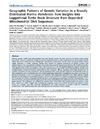Identificador persistente para citar o vincular este elemento:
https://accedacris.ulpgc.es/handle/10553/43550
| Título: | Geographic patterns of genetic variation in a broadly distributed marine vertebrate: new insights into loggerhead turtle stock structure from expanded mitochondrial DNA sequences | Autores/as: | Shamblin, Brian M. Bolten, Alan B. Abreu-Grobois, F. Alberto Bjorndal, Karen A. Cardona, Luis Carreras, Carlos Clusa, Marcel Monzon Argüello, Catalina Nairn, Campbell J. Nielsen, Janne T. Nel, Ronel Soares, Luciano S. Stewart, Kelly R. Vilaça, Sibelle T. Türkozan, Oguz Yilmaz, Can Dutton, Peter H. |
Clasificación UNESCO: | 2401 Biología animal (zoología) | Palabras clave: | Loggerhead turtle Genetic variation Chelonia-Mydas Populations Caretta-Caretta Green Turtle, et al. |
Fecha de publicación: | 2014 | Publicación seriada: | PLoS ONE | Resumen: | Previous genetic studies have demonstrated that natal homing shapes the stock structure of marine turtle nesting populations. However, widespread sharing of common haplotypes based on short segments of the mitochondrial control region often limits resolution of the demographic connectivity of populations. Recent studies employing longer control region sequences to resolve haplotype sharing have focused on regional assessments of genetic structure and phylogeography. Here we synthesize available control region sequences for loggerhead turtles from the Mediterranean Sea, Atlantic, and western Indian Ocean basins. These data represent six of the nine globally significant regional management units (RMUs) for the species and include novel sequence data from Brazil, Cape Verde, South Africa and Oman. Genetic tests of differentiation among 42 rookeries represented by short sequences (380 bp haplotypes from 3,486 samples) and 40 rookeries represented by long sequences (∼800 bp haplotypes from 3,434 samples) supported the distinction of the six RMUs analyzed as well as recognition of at least 18 demographically independent management units (MUs) with respect to female natal homing. A total of 59 haplotypes were resolved. These haplotypes belonged to two highly divergent global lineages, with haplogroup I represented primarily by CC-A1, CC-A4, and CC-A11 variants and haplogroup II represented by CC-A2 and derived variants. Geographic distribution patterns of haplogroup II haplotypes and the nested position of CC-A11.6 from Oman among the Atlantic haplotypes invoke recent colonization of the Indian Ocean from the Atlantic for both global lineages. The haplotypes we confirmed for western Indian Ocean RMUs allow reinterpretation of previous mixed stock analysis and further suggest that contemporary migratory connectivity between the Indian and Atlantic Oceans occurs on a broader scale than previously hypothesized. This study represents a valuable model for conducting comprehensive international cooperative data management and research in marine ecology. | URI: | https://accedacris.ulpgc.es/handle/10553/43550 | ISSN: | 1932-6203 | DOI: | 10.1371/journal.pone.0085956 | Fuente: | PLoS ONE [ISSN 1932-6203], v. 9 (1) (e85956) |
| Colección: | Artículos |
Citas SCOPUSTM
99
actualizado el 08-jun-2025
Citas de WEB OF SCIENCETM
Citations
88
actualizado el 08-jun-2025
Visitas
60
actualizado el 23-ene-2024
Descargas
80
actualizado el 23-ene-2024
Google ScholarTM
Verifica
Altmetric
Comparte
Exporta metadatos
Los elementos en ULPGC accedaCRIS están protegidos por derechos de autor con todos los derechos reservados, a menos que se indique lo contrario.
